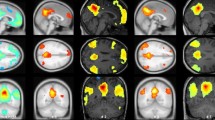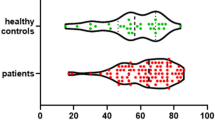Abstract
Objective
There is a lack of reliable tools used to predict functional recovery in unresponsive patients following a severe brain injury. The objective of the study is to evaluate the prognostic utility of resting-state functional magnetic resonance imaging for predicting good neurologic recovery in unresponsive patients with severe brain injury in the intensive-care unit.
Methods
Each patient underwent a 5.5-min resting-state scan and ten resting-state networks were extracted via independent component analysis. The Glasgow Outcome Scale was used to classify patients into good and poor outcome groups. The Nearest Centroid classifier used each patient’s ten resting-state network values to predict best neurologic outcome within 6 months post-injury.
Results
Of the 25 patients enrolled (mean age = 43.68, range = [19–69]; GCS ≤ 9; 6 females), 10 had good and 15 had poor outcome. The classifier correctly and confidently predicted 8/10 patients with good and 12/15 patients with poor outcome (mean = 0.793, CI = [0.700, 0.886], Z = 2.843, p = 0.002). The prediction performance was largely determined by three visual (medial: Z = 3.11, p = 0.002; occipital pole: Z = 2.44, p = 0.015; lateral: Z = 2.85, p = 0.004) and the left frontoparietal network (Z = 2.179, p = 0.029).
Discussion
Our approach correctly identified good functional outcome with higher sensitivity (80%) than traditional prognostic measures. By revealing preserved networks in the absence of discernible behavioral signs, functional connectivity may aid in the prognostic process and affect the outcome of discussions surrounding withdrawal of life-sustaining measures.



Similar content being viewed by others
Data availability
The codes used to analyze the data from this study is available at https://github.com/TheOwenLab/Acute-Resting-State. The deidentified fMRI data can be made available from the corresponding author, upon reasonable request.
Change history
13 October 2023
A Correction to this paper has been published: https://doi.org/10.1007/s00415-023-12018-0
References
Kamps MJA, Horn J, Oddo M et al (2013) Prognostication of neurologic outcome in cardiac arrest patients after mild therapeutic hypothermia: a meta-analysis of the current literature. Intensive Care Med 39(10):1671–1682. https://doi.org/10.1007/s00134-013-3004-y
Weijer C, Bruni T, Gofton T et al (2016) Ethical considerations in functional magnetic resonance imaging research in acutely comatose patients. Brain 139(1):292–299. https://doi.org/10.1093/brain/awv272
Norton L, Graham M, Kazazian K, Gofton T, Weijer C, Debicki D, Fernandez-Espejo D, Thenayan EA, Owen AM (2023) Use of functional magnetic resonance imaging to assess cognition and consciousness in severe Guillain-Barré syndrome. Int J Clin Health Psychol. https://doi.org/10.1016/j.ijchp.2022.100347
Edlow BL, Chatelle C, Spencer CA, Chu CJ, Bodien YG, O'Connor KL, Hirschberg RE, Hochberg LR, Giacino JT, Rosenthal ES, Wu O (2017) Early detection of consciousness in patients with acute severe traumatic brain injury. Brain 140(9):2399–2414. https://doi.org/10.1093/brain/awx176
Norton L, Hutchison RM, Young GB, Lee DH, Sharpe MD, Mirsattari SM (2012) Disruptions of functional connectivity in the default mode network of comatose patients. Neurology 78(3):175–181. https://doi.org/10.1212/WNL.0b013e31823fcd61
Threlkeld ZD, Bodien YG, Rosenthal ES et al (2018) Functional networks reemerge during recovery of consciousness after acute severe traumatic brain injury. Cortex 106:299–308. https://doi.org/10.1016/j.cortex.2018.05.004
Kondziella D, Fisher PM, Larsen VA et al (2017) Functional MRI for assessment of the default mode network in acute brain injury. Neurocrit Care 27(3):401–406. https://doi.org/10.1007/s12028-017-0407-6
Pugin D, Hofmeister J, Gasche Y et al (2020) Resting-state brain activity for early prediction outcome in postanoxic patients in a coma with indeterminate clinical prognosis. Am J Neuroradiol. https://doi.org/10.3174/ajnr.A6572
Wagner F, Hänggi M, Weck A, Pastore-Wapp M, Wiest R, Kiefer C (2020) Outcome prediction with resting-state functional connectivity after cardiac arrest. Sci Rep. https://doi.org/10.1038/s41598-020-68683-y
Silva S, de Pasquale F, Vuillaume C et al (2015) Disruption of posteromedial large-scale neural communication predicts recovery from coma. Neurology 85(23):2036–2044. https://doi.org/10.1212/WNL.0000000000002196
Lemm S, Blankertz B, Dickhaus T, Müller KR (2011) Introduction to machine learning for brain imaging. Neuroimage 56(2):387–399. https://doi.org/10.1016/j.neuroimage.2010.11.004
Wernick MN, Yang Y, Brankov JG, Yourganov G, Strother SC (2010) Machine learning in medical imaging. IEEE Signal Process Mag 27(4):25–38. https://doi.org/10.1109/MSP.2010.936730
Erickson BJ, Korfiatis P, Akkus Z, Kline TL (2017) Machine learning for medical imaging. Radiographics 37(2):505–515. https://doi.org/10.1148/rg.2017160130
Turgeon AF, Lauzier F, Simard JF et al (2011) Mortality associated with withdrawal of life-sustaining therapy for patients with severe traumatic brain injury: a Canadian multicentre cohort study. CMAJ Can Med Assoc J 183(14):1581–1588. https://doi.org/10.1503/cmaj.101786
Smith SM, Fox PT, Miller KL et al (2009) Correspondence of the brain’s functional architecture during activation and rest. Proc Natl Acad Sci 106(31):13040–13045. https://doi.org/10.1073/pnas.0905267106
Jennett B, Bond M (1975) Assessment of outcome after severe brain damage. Lancet Lond Engl 1(7905):480–484. https://doi.org/10.1016/s0140-6736(75)92830-5
Pedregosa F, Varoquaux G, Gramfort A et al (2011) Scikit-learn: machine learning in Python. J Mach Learn Res 12(85):2825–2830
Nichols TE, Holmes AP (2002) Nonparametric permutation tests for functional neuroimaging: a primer with examples. Hum Brain Mapp 15(1):1–25. https://doi.org/10.1002/hbm.1058
Cohen MX, Grafman J (2014) Analyzing neural time series data: theory and practice. MIT Press, Cambridge. http://ebookcentral.proquest.com/lib/west/detail.action?docID=3339728. Accessed 1 Aug 2022
Sandroni C, D’Arrigo S, Nolan JP (2018) Prognostication after cardiac arrest. Crit Care 22(1):150. https://doi.org/10.1186/s13054-018-2060-7
Amiri M, Fisher PM, Raimondo F et al (2022) Multimodal prediction of residual consciousness in the intensive care unit: the CONNECT-ME study. Brain. https://doi.org/10.1093/brain/awac335
Snider SB, Bodien YG, Frau-Pascual A, Bianciardi M, Foulkes AS, Edlow BL (2020) Ascending arousal network connectivity during recovery from traumatic coma. NeuroImage Clin 28:102503. https://doi.org/10.1016/j.nicl.2020.102503
Demertzi A, Antonopoulos G, Heine L et al (2015) Intrinsic functional connectivity differentiates minimally conscious from unresponsive patients. Brain 138(9):2619–2631. https://doi.org/10.1093/brain/awv169
Laird AR, Fox PM, Eickhoff SB et al (2011) Behavioral interpretations of intrinsic connectivity networks. J Cogn Neurosci 23(12):4022–4037. https://doi.org/10.1162/jocn_a_00077
Karapanagiotidis T, Jefferies E, Smallwood J (1817) Interactions between the neural correlates of dispositional internally directed thought and visual imagery. Philos Trans R Soc B 2021(376):20190691
Peran P, Malagurski B, Nemmi F et al (2020) Functional and structural integrity of frontoparietal connectivity in traumatic and anoxic coma. Crit Care Med 48(8):e639–e647. https://doi.org/10.1097/CCM.0000000000004406
Naci L, Sinai L, Owen AM (2017) Detecting and interpreting conscious experiences in behaviorally non-responsive patients. Neuroimage 145:304–313. https://doi.org/10.1016/j.neuroimage.2015.11.059
Malagurski B, Péran P, Sarton B et al (2017) Neural signature of coma revealed by posteromedial cortex connection density analysis. NeuroImage Clin 15:315–324. https://doi.org/10.1016/j.nicl.2017.03.017
Koenig MA, Holt JL, Ernst T et al (2014) MRI default mode network connectivity is associated with functional outcome after cardiopulmonary arrest. Neurocrit Care 20(3):348–357. https://doi.org/10.1007/s12028-014-9953-3
Kazazian K, Norton L, Laforge G et al (2021) Improving diagnosis and prognosis in acute severe brain injury: a multimodal imaging protocol. Front Neurol 12:757219. https://doi.org/10.3389/fneur.2021.757219
Fernández-Espejo D, Owen AM (2013) Detecting awareness after severe brain injury. Nat Rev Neurosci 14(11):801–809. https://doi.org/10.1038/nrn3608
Sarigul B, Bell RS, Chesnut RM et al (2023) Prognostication and withdrawal of care decisions in severe traumatic brain injury: a survey of the Seattle International Severe Traumatic Brain Injury Consensus Conference (SIBICC) Working Group. J Neurotrauma. https://doi.org/10.1089/neu.2022.0414
Poldrack RA, Huckins G, Varoquaux G (2020) Establishment of best practices for evidence for prediction: a review. JAMA Psychiat 77(5):534–540. https://doi.org/10.1001/jamapsychiatry.2019.3671
Kondziella D, Bender A, Diserens K et al (2020) European Academy of Neurology guideline on the diagnosis of coma and other disorders of consciousness. Eur J Neurol 27(5):741–756. https://doi.org/10.1111/ene.14151
Kondziella D, Menon DK, Helbok R et al (2021) A precision medicine framework for classifying patients with disorders of consciousness: Advanced Classification of Consciousness Endotypes (ACCESS). Neurocrit Care 35(1):27–36. https://doi.org/10.1007/s12028-021-01246-9
Rossetti AO, Rabinstein AA, Oddo M (2016) Neurological prognostication of outcome in patients in coma after cardiac arrest [published correction appears in Lancet Neurol. 2016 Jun;15(7):656]. Lancet Neurol 15(6):597–609. https://doi.org/10.1016/S1474-4422(16)00015-6
Acknowledgements
The authors gratefully acknowledge the dedication of the bedside nurses and MRI technologists for making the acquisition of these data possible. The authors would also like to extend our thanks to the patients and families who participated in this study.
Funding
This research was funded by the Canada Excellence Research Chairs (CERC) program (#215063) and the Canadian Institutes of Health Research (CIHR, #408004).
Author information
Authors and Affiliations
Contributions
MK, KK, AMO, and LN contributed to the conception and design of the study; MK, KK, KR, and LN contributed to the acquisition and analysis of data; MK, KK, KR, SLN, CW, TEG, DD, AMO, and LN contributed to drafting the text or preparing the figures.
Corresponding author
Ethics declarations
Conflicts of interest
The authors declare no conflicts of interest.
Ethical standard
The study was conducted according to the guidelines of the Declaration of Helsinki of 1964 and later amendments, and approved by the Health Sciences Research Ethics Board of Western University.
Supplementary Information
Below is the link to the electronic supplementary material.
Rights and permissions
Springer Nature or its licensor (e.g. a society or other partner) holds exclusive rights to this article under a publishing agreement with the author(s) or other rightsholder(s); author self-archiving of the accepted manuscript version of this article is solely governed by the terms of such publishing agreement and applicable law.
About this article
Cite this article
Kolisnyk, M., Kazazian, K., Rego, K. et al. Predicting neurologic recovery after severe acute brain injury using resting-state networks. J Neurol 270, 6071–6080 (2023). https://doi.org/10.1007/s00415-023-11941-6
Received:
Revised:
Accepted:
Published:
Issue Date:
DOI: https://doi.org/10.1007/s00415-023-11941-6




